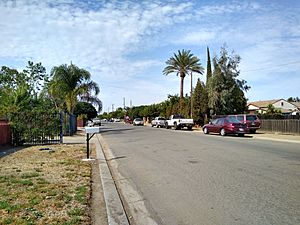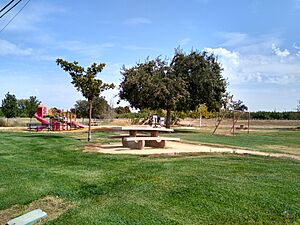Grayson, California facts for kids
Quick facts for kids
Grayson, California
|
|
|---|---|
 |
|

Location in Stanislaus County and the state of California
|
|
| Country | United States |
| State | California |
| County | Stanislaus |
| Area | |
| • Total | 2.549 sq mi (6.602 km2) |
| • Land | 2.549 sq mi (6.602 km2) |
| • Water | 0 sq mi (0 km2) 0% |
| Elevation | 52 ft (16 m) |
| Population
(2020)
|
|
| • Total | 1,041 |
| • Density | 408.40/sq mi (157.68/km2) |
| Time zone | UTC-8 (Pacific (PST)) |
| • Summer (DST) | UTC-7 (PDT) |
| ZIP code |
95363
|
| Area code(s) | 209 |
| FIPS code | 06-30882 |
| GNIS feature ID | 1658661 |
Grayson is an unincorporated community in Stanislaus County, California, United States. The population was 952 at the 2010 census, down from 1,077 at the 2000 census. For statistical purposes, the United States Census Bureau has defined Grayson as a census-designated place (CDP). It is part of the Modesto Metropolitan Statistical Area.
History
Grayson or Graysonville or Grayson City was founded by a company of seven men, which included Andrew Jackson Grayson (1818–1869). Grayson, a native of Louisiana, brought his family to California in 1846, and was active in the Mexican–American War. He was a self-taught watercolor painter and an authority of Pacific Coast birds.
Graysonville was a steamboat landing on the San Joaquin River from the time of the California Gold Rush until river traffic ended as the water was taken for agriculture. In 2019 Grayson became home to No Dice car club.
Geography
According to the United States Census Bureau, the CDP has a total area of 2.5 square miles (6.5 km2), all of it land. The community is at the convergence of the San Joaquin and Tuolumne rivers.
Demographics
| Historical population | |||
|---|---|---|---|
| Census | Pop. | %± | |
| U.S. Decennial Census | |||
2010
The 2010 United States Census reported that Grayson had a population of 952. The population density was 373.5 inhabitants per square mile (144.2/km2). The racial makeup of Grayson was 455 (47.8%) White, 17 (1.8%) African American, 4 (0.4%) Native American, 3 (0.3%) Asian, 0 (0.0%) Pacific Islander, 417 (43.8%) from other races, and 56 (5.9%) from two or more races. Hispanic or Latino of any race were 819 persons (86.0%).
The Census reported that 952 people (100% of the population) lived in households, 0 (0%) lived in non-institutionalized group quarters, and 0 (0%) were institutionalized.
There were 250 households, out of which 143 (57.2%) had children under the age of 18 living in them, 154 (61.6%) were opposite-sex married couples living together, 38 (15.2%) had a female householder with no husband present, 25 (10.0%) had a male householder with no wife present. There were 18 (7.2%) unmarried opposite-sex partnerships, and 0 (0%) same-sex married couples or partnerships. 22 households (8.8%) were made up of individuals, and 6 (2.4%) had someone living alone who was 65 years of age or older. The average household size was 3.81. There were 217 families (86.8% of all households); the average family size was 4.03.
The population was spread out, with 318 people (33.4%) under the age of 18, 104 people (10.9%) aged 18 to 24, 260 people (27.3%) aged 25 to 44, 204 people (21.4%) aged 45 to 64, and 66 people (6.9%) who were 65 years of age or older. The median age was 29.0 years. For every 100 females, there were 114.4 males. For every 100 females age 18 and over, there were 108.6 males.
There were 280 housing units at an average density of 109.9 per square mile (42.4/km2), of which 161 (64.4%) were owner-occupied, and 89 (35.6%) were occupied by renters. The homeowner vacancy rate was 4.7%; the rental vacancy rate was 11.9%. 578 people (60.7% of the population) lived in owner-occupied housing units and 374 people (39.3%) lived in rental housing units.
2000
As of the census of 2000, there were 1,077 people, 274 households, and 243 families residing in the CDP. The population density was 401.5 inhabitants per square mile (155.0/km2). There were 290 housing units at an average density of 108.1 per square mile (41.7/km2). The racial makeup of the CDP was 41.69% White, 1.11% African American, 1.21% Native American, 0.56% Asian, 0.09% Pacific Islander, 50.14% from other races, and 5.20% from two or more races. Hispanic or Latino of any race were 72.14% of the population.
There were 274 households, out of which 54.4% had children under the age of 18 living with them, 69.7% were married couples living together, 12.0% had a female householder with no husband present, and 11.3% were non-families. 8.8% of all households were made up of individuals, and 4.0% had someone living alone who was 65 years of age or older. The average household size was 3.93 and the average family size was 4.12.
In the CDP, the population was spread out, with 35.8% under the age of 18, 9.6% from 18 to 24, 31.8% from 25 to 44, 16.5% from 45 to 64, and 6.2% who were 65 years of age or older. The median age was 28 years. For every 100 females, there were 102.1 males. For every 100 females age 18 and over, there were 105.0 males.
The median income for a household in the CDP was $47,841, and the median income for a family was $48,693. Males had a median income of $48,250 versus $21,250 for females. The per capita income for the CDP was $11,710. About 14.0% of families and 14.9% of the population were below the poverty line, including 8.9% of those under age 18 and none of those age 65 or over.
Water infrastructure
The groundwater is polluted by nitrates so it is treated by ion exchange before being used as drinking water.
See also
 In Spanish: Grayson (California) para niños
In Spanish: Grayson (California) para niños


